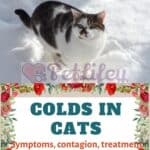
Throughout this article we will talk specifically about Fungi in cats. What are the diseases caused by fungi in cats, their symptoms, treatments to combat them and how to prevent them.
It is normal to want to take care of your cat by preventing it from being infected with any disease or virus present in another sick cat or in the environment.
However, despite the fact that cats are independent and strong animals, this task is quite difficult.
Since in the environment there are a large number of viruses, bacteria and fungi that can affect the immune system of your cat, causing diseases in the body.
What are mushrooms?
Fungi are eukaryotic organisms (nucleus with cell membrane) that inhabit the environment and feed on dead organic components, that is, in a state of decomposition.
In fact this is its function in the environment, helping to break down dead matter along with bacteria and other organisms.
Fungal Diseases in Cats
Fungi, in addition to feeding on dead organic matter, also tend to inhabit and feed on the tissues of living organisms, consuming nutrients and amino acids from the body’s cells.
And this situation can cause diseases in said organism, which begin with a topical infection but can also affect the internal functioning of the organs.
It is for this reason that there are fungi in cats that can enter their body through wounds or ulcers on the skin or even through the respiratory tract , producing diseases among which are:
Dermatophytosis or ringworm in cats:
The ringworm in cats is produced by the fungus Microsporum Canis. This fungus causes a topical infection on the cat’s skin, including nails, and young cats and long-haired cats are also more likely to be infected.
This fungus develops spores that are quite contagious and can survive in the environment for a long time. It is for this reason that it is recommended not only to apply a treatment to the cat’s skin, but also to disinfect the entire home through the use of specialized chemicals.
Symptoms
- Loss of hair in circular patches of skin such as: cat’s head, ears and feet.
- Inflamed and flaky patches of hairless skin.
- Constant itching
Treatment
- Delivery of oral medication through antifungal fluids such as Itraconazole.
- Supply of topical therapy through the use of medicated shampoos.
- Elimination and total cleaning of hairs that may be in the environment where the animal lives, since that is where the spores are housed.
Cryptococcosis:
Cryptococcosis disease is caused by a fungus called Cryptococcus neoformans, which lives mainly in places contaminated by the excrement of birds such as pigeons.
These fungi in cats appear in spores that are inhaled by it and affect to a greater extent a cat that has a low level of defences.
If the infection develops and is not treated in time, it can reach the brain, seriously affecting the eyes (blindness) and causing meningitis.
Symptoms
- Coughing and sneezing
- Difficulty breathing
- Nose bleeds
- Swelling of the face and nose
- Subcutaneous granulomas
- If it reaches the brain, it may present incoordination, blindness and seizures.
Treatment
- Long-term supply of antifungals orally. (ketoconazole)
- Supply of fungicides such as: flucytosine and amphotericin B.
- If the skin is severely affected, surgery to remove the subcutaneous granulomas may be needed in addition to the above medications.
Histoplasmosis:
Histoplasmosis is caused by the fungus Histoplasma capsulatum. This disease is usually common in places where the soil is rich in nitrogen and where organic matter and the droppings of birds and bats abound.
Since this is the medium in which the fungus occurs most easily. The disease must be detected time and treatment applied, since it is sometimes confused with lung disease.
This disease can be treated but in most cases the affected cats die.
Symptoms
- Lack of coordination to walk
- Fever
- Decay and weakness
- Decreased appetite
- Respiratory distress
- Dry cough
- Eye affection
Treatment
- It must be diagnosed by performing seriological tests, complete blood counts, among others.
- Provision of antifungal drug treatment.
Sporotrichosis:
The sporotrichosis is a disease caused by fungi spores esporothrix. This fungus is found in the environment and can be transmitted to animals such as cats but also to humans. By inhalation, through skin wounds or even by ingesting the fungus.
Symptoms
- Wounds and nodules on the skin without hair on the face, legs and tail.
- Swollen lymph nodes
- General malaise and fever
- Spread to the bones, joints, and brain
- Cough and pneumonia
- Weightloss
Treatment
- Supply of systemic antifungal medications for several weeks
- Use of antifungals such as ketoconazole and itraconazole for a period of 4 to 8 weeks.
How to prevent fungus in cats?

There are effective treatments and medicines to fight fungus in cats. However, the best treatment will always be prevention. That is why below we will give you the best tips to take care of your cat’s health by preventing infection with fungi.
- Optimal hygiene: cleaning both your cat and the environment where it lives is crucial. A clean, infection-free home is a safe place for your cat and the whole family in general.
- Quality food: a complete diet in nutrients is important when it comes to keeping your cat’s defences high. For a strong immune system it is easier to fight any infection caused by fungi.
- If there is another pet or human being infected with a fungal disease in the home, it will be important to isolate them and disinfect the home so that the diseases do not spread to other members of the household, including your cat.
- Discard household items such as blankets, pillows, and rugs that can harbour fungus spores and are difficult to clean.
- While you are treating a person infected with any of these diseases, wear gloves and masks. In addition, afterwards it is important that you bathe to disinfect yourself from any possible contagion that you can later transmit to your cat.
By following these tips, you can take care of your cat from acquiring not only fungal diseases but also any type of disease that is contagious.
This article is only informative and never optional, remember that in case you see any symptoms or strange behaviour of your cat, the first thing you should do is go immediately to an expert veterinarian who can diagnose and prescribe the appropriate treatment.
We hope this article has been of interest to you and you have learned a little more about fungi in cats, the diseases it produces and especially how to prevent them. Now you can purr it on social media if you think this information can help someone else.






